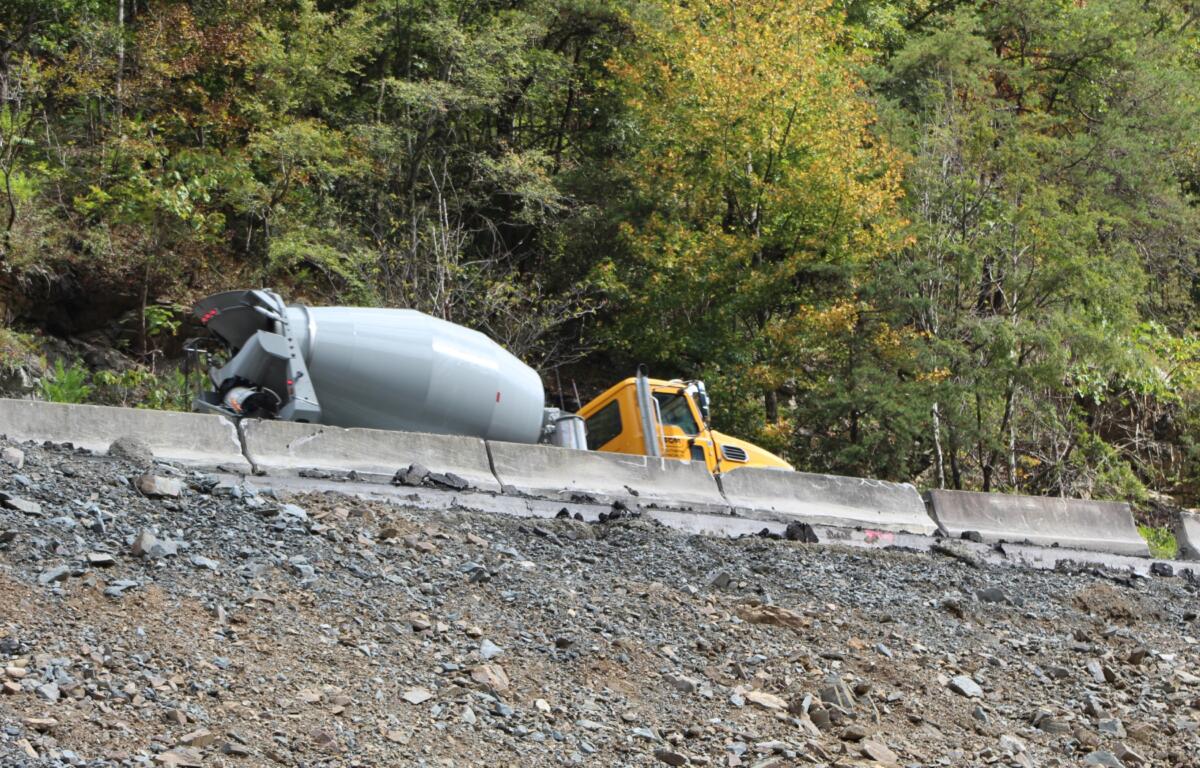HAYWOOD COUNTY, N.C. (828newsNOW) — The sound of tractor-trailers rumbling through the Pigeon River Gorge may be routine again, but for Gov. Josh Stein and state transportation crews, the traffic is a reminder of what it took to get here.
A year ago, Tropical Storm Helene ripped through Western North Carolina, sending walls of water down mountainsides, tearing apart roads and severing lifelines that tied rural communities together. Entire stretches of Interstate 40 collapsed into the river. In the days after the storm, silence replaced the usual roar of traffic.
On Friday, standing along a 4-mile section of I-40 that was among the hardest hit, Stein and a host of state and federal officials marked the storm’s one-year anniversary with a mix of gratitude, remembrance and resolve.
“Helene damaged 9,400 sites along roads and bridges, and the damage forced 1,450 complete road closures. Over 1,400 roads completely shut down,” Stein said. “This section of I-40 on the Pigeon River Gorge was one of the roads that we had to close. This project is truly a symbol of our greater recovery efforts.”
Thanks to the urgency and grit of NCDOT employees and contractors, 97 percent of those roads are now back open, the governor said.
The storm claimed 108 lives statewide, left tens of thousands homeless and shuttered businesses across the mountains. For transportation officials, it was the most destructive storm in North Carolina’s history — nearly $5 billion in damage to highways, bridges, culverts and pipes.
Yet, within five months, crews reopened I-40 through the gorge, stabilizing 10 sites in one of the most challenging landscapes in the Southeast. That quick work came only after emergency repairs, creative partnerships and long hours in hazardous conditions, officials said.
Federal Highway Administrator Sean McMaster called the work a model for disaster recovery, announcing $1.15 billion in new federal aid — the largest single allocation of emergency relief ever to one state. Combined with earlier grants, nearly $2 billion will flow to North Carolina to continue rebuilding.
“I-40 is a vital interstate that allows people and goods to travel across Western North Carolina through the mountains of Eastern Tennessee,” McMaster said. “From families taking road trips to large freight trucks, the impact of I-40 travel has been felt throughout North Carolina. I cannot overstate the impact, which is why fully reopening I-40 is a top priority for USDOT.”
Partnerships proved critical. The U.S. Forest Service allowed the state to pull rock and aggregate from Pisgah National Forest instead of hauling material from miles away, saving time and millions of dollars.
“It’s a strength of that collaboration that made this celebration possible,” Forest Service Supervisor James Malonas said. “The work to rebuild I-40 is easily one of the most important recovery projects in Western North Carolina, if not the single most important.”
Even as officials celebrated progress, Stein said much more remains. He called on Congress to approve another $13.5 billion in disaster funding, noting North Carolina has so far received only 11 percent of its estimated storm recovery needs.
“The people of Western North Carolina deserve their fair share,” Stein said. “We have not forgotten you, and we will not forget you.”
For outgoing Transportation Secretary Joey Hopkins, the ceremony was also personal. He recalled how NCDOT crews risked their lives during the storm, turning motorists back as the interstate collapsed beneath them.
“Our crews’ efforts have been historic and heroic,” he said.
Incoming Secretary Daniel Johnson pledged to continue that work.
“While it’s important to reflect on the many accomplishments over the past year, there is no time to rest until the restoration is complete,” Johnson said.
As officials spoke, cars and trucks thundered past — a sign of recovery, but also a reminder of the miles of mountain roadway still scarred by Helene. The sound, Stein noted, was fitting.
“It means people can get from North Carolina to Tennessee and beyond,” the governor said. “And it means Western North Carolina is still connected.”








